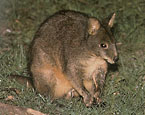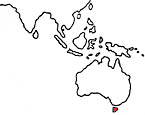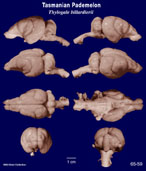|
Tasmanian
Pademelon
(Thylogale billardierii) #65-59 |
||||
|
|
Physical
characteristics and distribution
|
|
The
head and body length of T. billardierii is from 290-630
mm, with a tail length of 270-510 mm. Adults weigh between 1.8
and 12 kg. Known as the Red-bellied pademelon, the color of
the upper parts is grayish brown tinged with olive and a yellowish
hip stripe is often visible. The under parts are either rufous
or orange. The tail is comparatively short , thick and sparsely
haired. |
|
Description
of the brain
|
|
Animal
source and preparation
|
|
All
specimens collected followed the same preparation
and histological procedure.
|
Other Related Resources (websites and publications)
List of Specimens | Explore Collections | Brain Sections | Brain Evolution | Brain Development | Brain Circuitry | Brain Functions | Location and Use | Related Web Sites | Contact Us | Search MSU Database | Personnel | Home



